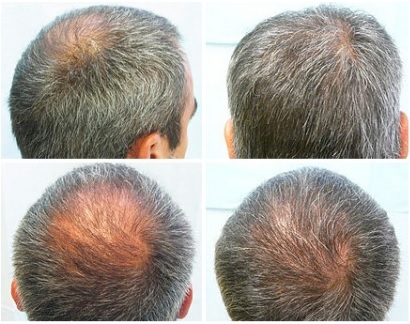Insights On Conducting Body Hair Transplant By Dr. Umar
Dr. Umar has also published a series of hair transplant articles where he shares his own research and insights on conducting body hair transplant surgery and other methods for challenging patient cases. These include:
- Anagen Hair Clinic: Dr. Umar tested the assumption that only anagen hairs should be selected from the shaved donor area during the hair transplant extraction phase. This article discusses what he found. Full Article
- Vellus Body Hair to Scalp Transplantation: Dr. Umar provides his insight on whether or not vellus hairs undergo a transformation in hair thickness caliber once they are transplanted to a different location. Full Article|PDF Version

- Hairline Feathering, A New Role for Body Hair Transplantation: In this article, Dr. Umar discusses the importance of creating a soft, natural looking hairline edge. Since hairs like those from the leg area are quite thin, they make an excellent choice for reproducing this feature. Therefore, body hair transplantation can play a significant role in helping patients achieve the most realistic and undetectable results possible. Full Article|PDF Version

- Wound Healing Sequelaes Post BHT (Variations in Healing Course Following BHT): Dr. Umar points out that different skin types can be expected to display different wound healing characteristics. This is often to the varying levels of melanin that are released as a result of the donor wounds created during a hair transplant procedure. Full Article| PDF Version
 :
: - Wound Sizes, Configuration and BHT Wound Healing Most people consider graft integrity to be an important variable for successful cosmetic results in a hair restoration procedure. However, Dr. Umar attempts to broaden this perspective by highlighting the importance of wound healing results which can affect how short the patient is able to wear their hair. Full Article|PDF Version

- Hair Cycles and Body Hair Transplantation (BHT): Dr. Umar addresses the question of whether or not only telogen hairs should be selected for hair transplant extractions. Full Article|PDF Version

- The Importance of Hair Cycles and Body Hair Extraction: In this article, Dr. Umar discusses whether it is easier to remove anagen or telogen hairs and which of these hair follicle states are likely to produce in tact grafts. Full Article|PDF Version

- Body Hair Transplant Testing – Basic Principles – Basic Principles: Before undergoing a body hair transplant, patients may want to consider a preliminary test on small, inconspicuous areas of the body. Dr. Umar discusses what information can be gathered from this experience. Full Article| Body Hair Transplant Testing – Basic Principles

- Camouflaing the Scar of Strip Surgery (Scalp Involved) Hair Transplants By FUE/BHT (Scalp Involved) Hair Transplants by FUE/BHT: Patients who had already undergone a strip procedure may want to camouflage their linear scar. This can be achieved quite successfully by extracting grafts from the scalp using Follicular Unit Extraction. If the donor supply on the head has been exhausted, then Body Hair Transplantation can offer another option for acquiring the necessary grafts. Inserting these follicles into the scar tissue can produce exceptional coverage that enables patients to confidently wear their hair quite short. Full Article|PDF Version

- American Academy of Dermatology (AAD): Dr. Umar summarizes the hair loss presentation at the 65th Annual Convention of the American Academy of Dermatology (AAD) which focused on the need for developing effective solutions for female hair loss. Full Article|PDF Version

- The Role of 5 Alpha Reductase Inhibitors on BHT : 5 Alpha Reductase Inhibitors are often used in hair loss medications to help prevent testosterone from breaking down into DHT (dehydrotestosterone). Dr. Umar informs readers that body hairs tend to thrive in the presence of DHT, unlike head hair. Therefore, these inhibitors can actually reduce hair growth on the body. Full Article|PDF Version


